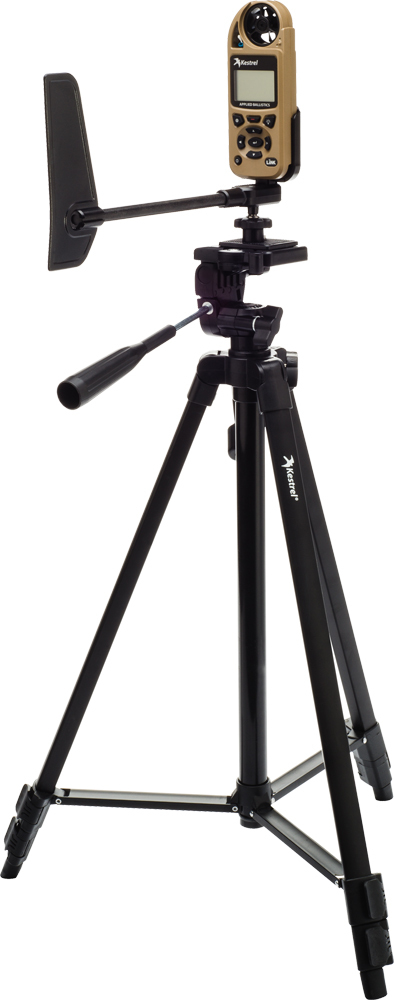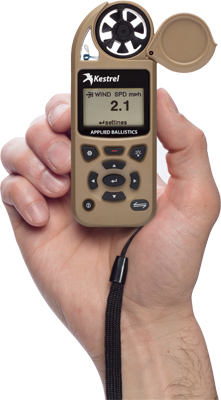Consistent long range shooting is a game of data, math, and skill. The data part is relatively straightforward and repeatable if you understand the variable and have the right tools. The math can now be handled by ballistic computer software in various smartphones or devices. The skill part? Well, that takes experience and lots of practice.
To grossly oversimplify, there are three sets of data you need to mash up, churn and spit out to calculate a perfect firing solution resulting in a first shot hit.
- Gun and bullet performance data
- Current atmospheric conditions
- Target range, relative elevation to your position, and speed
Once you have the input data, it’s time to do the fancy ballistic math and figure out exactly how much you’ll need to adjust your hold to account for bullet drop and drift.
In a way, the new Kestrel Elite can help you gather accurate inputs for most all three sets of data. Rather than rattle off specifications and features, let’s take a look at a shooting scenario and how the Kestrel might be used.
Using the Kestrel
For brevity, we’ll assume that you've already completed the initial setup and calibration. Unlike most modern electronic device makers, Kestrel includes an actual printed manual to help you through that process.
One of the input data sets will include your rifle and ammunition performance information. You’ll need to tell the Kestrel the characteristics of your bullet including ballistic coefficient, weight, length, caliber, and specific muzzle velocity from your rifle. If you don’t have a chronograph, no worries, you can shoot a group at a longer distance and tell the Kestrel how many inches the bullets dropped. It will then calculate the actual muzzle velocity.
Once in position and ready to shoot, you’ll need to capture current atmospheric conditions. The Kestrel is capable of reporting either station pressure, which is used by the embedded ballistic software, or barometric pressure, which weather geeks use to measure air pressure adjusted to sea level. The unit includes sensors to continuously gather things like temperature, wind chill, relative humidity, dewpoint temperature, pressure, and altitude, so once original setup is complete you don’t have to worry too much about that.
Since the device has a built-in compass and wind impeller, you can take nifty shortcuts to determine not only wind velocity, but the crosswind component. Point the unit into the wind to gather the current wind velocity. Then, point it at your target and hit the snapshot button. This tells the Kestrel the compass heading to your target relative to the wind direction so that it can determine the crosswind impact. Oh, the compass heading also allows the Kestrel to worry about things like Coriolis Effect, so as the earth turns during the flight of your projectile, the shooting solution will already have accounted for that depending on the direction of your shot.
Next, you need to determine the range and speed of your target. Since the new Kestrel Elite model has LiNK Bluetooth capability, you can interface it with something like a Bushnell Elite 1 Mile CONX rangefinder. If you don’t have one of those, the Kestrel can help you determine range too. Just enter the size of your target and the number of mils or MOA that it covers on your scope reticle, and the unit will calculate the estimated range. If you have time, the Kestrel can also be used to estimate the speed of moving targets using time and reticle mark inputs.
The device does the math, based on all of this information, and shows a shooting solution using units of your choice like milliradians, minutes of angle, or even scope clicks based on your optic's adjustment per click model. Even if there is no wind, you’ll likely see a windage adjustment to account for spin drift and Coriolis Effect, remember?
This scenario represents a small taste of the capabilities of the Kestrel Elite with Applied Ballistics software - one could write a book to include all the details and options.
What does LiNK do?

With the LiNK system, you can set up the weather meter separate from your shooting position. This wind vane mount tracks current wind direction.
The Bluetooth connectivity feature is one of those things that offers far more than “cool use of technology.” The previous Kestrel 4500 model offered basic Bluetooth communication that allowed loading of detailed gun, ammo, and drag curve information. The new Elite model with LiNK goes much further.
For starters, it allows the use of a companion app to load data into the Kestrel Applied Ballistics software. While you can enter data including gun and bullet profiles directly into the Kestrel, it can be tiresome as you’re limited to using the handful of multipurpose buttons on the Kestrel unit itself. Entering data is far easier when using a computer (Windows or Mac) or smartphone (Android or iOS).
LiNK also works in both directions. While it makes quick work of moving data to the Kestrel, it also allows smartphones to display data from the Kestrel. If you like, you can set the Kestrel unit up on a tripod or stand and use your smartphone to display the targeting solution information calculated by the Kestrel Elite. If you want to get fancy, use Kestrel’s optional wind vane mount so continuous wind direction and velocity information can be transmitted to your mobile device while you remain in a shooting position. That means you can place your unit where it can best keep tabs on changing environmental conditions. Your shooting solution will be continuously updated right where you need it - next to your gun.
LiNK also powers two new smartphone applications from Kestrel: Kestrel LiNK and Kestrel LiNK Ballistics. The standard LiNK app provides remote control and data collection functionality. If you place the Kestrel Elite (or other LiNK compatible models) within 30 feet of your shooting position, you can see the output from the Elite unit. The Ballistics app allows users to remote control the Kestrel Elite, manage gun and bullet library information, and create custom drag models. It also allows the shooter to manage multiple targets and quickly switch between solutions views for each. Both apps are free for Elite owners.
The LiNK function extends to third party developers too. For example, the popular Ballistic App now integrates with the Kestrel Elite, automatically feeding real-time environmental data into the full-featured smartphone applications. While the Kestrel Elite models allow configuration of specific cartridge loads, the Ballistic App contains a pre-built library documenting the performance of thousands of off-the-shelf cartridge and bullet combinations. Current Ballistic App users can access this Kestrel integration through a simple in-app purchase for $14.99.
“We're pleased to add the power of Kestrel® environmental measurements to the Momentum Labs Ballistics app. With accurate on-site wind speed and air density measurements sent wirelessly to the user's iOS device, the Ballistics app can now calculate far more precise firing solutions. Kestrel's Bluetooth Smart communications protocol is designed to make this integration seamless for app developers and users, and we've enjoyed working with Momentum Labs on this project," says Alix James, CEO of Nielsen-Kellerman.
Elite and Sportsman Models
The LiNK system is available on two different Kestrel models, the Elite and Sportsman. The basic features are similar, but the Elite model offers custom drag model configuration and multi-target management in conjunction with the Link Ballistics App.
The Elite model MSRP is $709 with LiNK and $609 without the Bluetooth connectivity features. The Sportsman goes for $559 with LiNK and $419 without LiNK.







